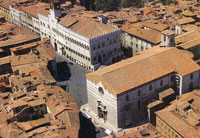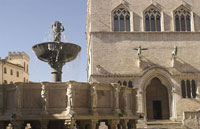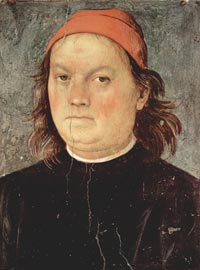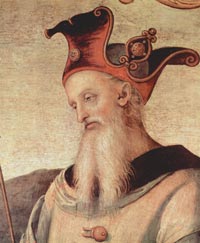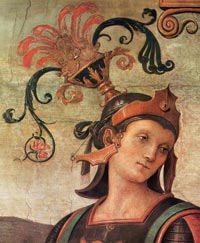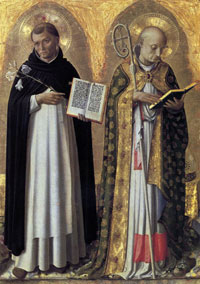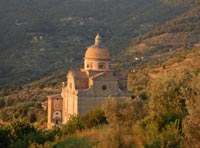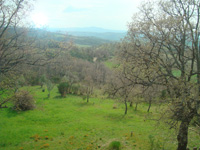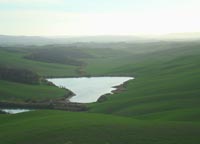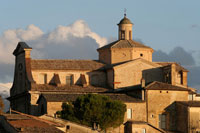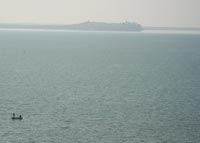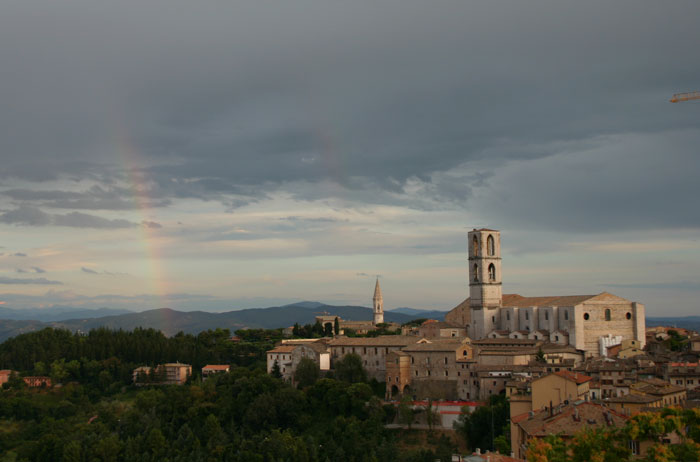 |
|
Perugia |
|
Perugia |
| Perugia is an enchanting hilltop city with a compact historic center that is a rambling maze of medieval streets. Perugia dominates the Tiber Valley from a high, irregular and rough hill: the particular feature of the land has generated a wide variety of urbanistic situations, giving the town a very special aspect. The rich artistic and cultural patrimony and the natural environment make Perugia an unique city of major importance, and this from the beginning of its history. Perugia lies on a hill inhabited ever since the prehistoric times; it was first a settlement of the Umbrians, then it passed under the rule of the Etruscans, becoming one of the most important cities in the High Tiber Valley. The famous Fontana Maggiore stands at the centre of Piazza IV Novembre. Piazza Quattro Novembre |
||
| The main square, Piazza Quattro Novembre, is dominated by the Fontana Maggiore. To the rear rises the plain-faced Duomo San Lorenzo and to the south the Palazzo dei Priori with its unusual staircase that fans out into IV November Square. In this area, the most ancient public building on the record was the Consul's Palace, linking the Duomo to the Bishop's Palace, complete destroyed by fires and reconstruction work in 16th C. The Palazzo dei Prior (Town Hall) construction begun in 1270 and went on until 1353. From 1429 to 1443, a further extension was carried out. The later structural addition on the South side date from the 1576-1588. The facade which looks onto the Fontana Maggiore has a wide, semi-circular staircase, built in 1902, the old one designed by Ambrogio Maitani having been destroyed at the end of the 16th century. The Fontana Maggiore, a medieval fountain designed by Fra Bevignate and sculpted by Nicola and Giovanni Pisano, islocated between the cathedral and the Palazzo dei Priori. The fountain was part of program of civic improvements begun in 1278 to celebrate the autonomy of the free commune of Perugia. It was built as a monument to celebrate the success of the completion of the aqueduct which carried water from Monte Pacciano directly into the main square. The fountain was erected in 1277 under the supervision of architect Fra Bevignate. The hydraulic system was designed by Boninsegna da Venezia and the decorative sculptures were executed by the father-and-son, Nicola and Giovanni Pisano. On the twenty-five sides of the basin are sculptures representing prophets and saints, the labors of the months, the signs of the zodiac, scenes from Genesis, and events from Roman history. The Cathedral of San Lorenzo is the main religious edifice of Perugia. |
|
|
Pozzo Etruscon fontana maggiore, Perugia (2)
|
||
The current cathedral, dedicated from the beginning as the Cathedral of San Lorenzo and Sant'Ercolano[1] dates from a project of 1300 by Fra Bevignate that was initiated in 1345 and completed in 1490. The external decoration in white and pink marble lozenges (adapted from the Cathedral of Arezzo) was never completed; a trial section can still be seen on the main façade. |
||
| Perugia has had a rich tradition of art and artists. Perugia’s most celebrated painter, Pietro Vannucci, who was also known as Perugino, once had an even more famous pupil: the Renaissance master Raphael. To see both artists’ handiwork simultaneously, visit the Cappella di San Severo (Piazza Raffaello; 39-075-573-3864; perugiacittamuseo.it), where a fresco in the minuscule chapel is said to have sprung from the brushes of both Raphael (top half) and Perugino (bottom half). A more extensive view of Perugino’s oeuvre is in the Galleria Nazionale dell’Umbria, an impressive collection of Umbrian art is housed in the Palazzo dei Priori, a grand stone building dating from the 13th century. The the Galleria Nazionale dell'Umbria in Perugia houses a number of masterpieces, including the Madonna with Child and six Angels, which represents the Renaissance Marian art of Duccio. And the private Art Collection of the Fondazione Cassa di Risparmio di Perugia has two separate locations. The Collegio del Cambio is an extremely well preserved representation of a Renaissance building and houses a magnificent Pietro Perugino fresco. |
||
Galleria Nazionale dell'Umbria |
||
The Galleria Nazionale dell'Umbria is the Italian national paintings collection of Umbria, housed in the Palazzo dei Prior. Its collection comprises the greatest representation of the Umbrian School of painting, ranging from the 13th to the 19th century, strongest in the fourteenth through sixteenth centuries. The collection is presented in twenty-three galleries in the Palazzo.
|
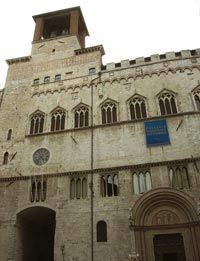 Galleria Nazionale dell’Umbria |
|
| The Collegio del Cambio (seat of the guild) [in Palazzo dei Priori] was built between 1452 and 1457. The entrance doorway is a beautifully crafted work in wood that dates back to 1505. In 1499 the guild of the cambio (money-changers or bankers) of Perugia asked him to decorate their audience-hall, the Sala delle Udienze del Collegio del Cambio. The humanist Francesco Maturanzio acted as his consultant. This extensive scheme, which may have been finished by 1500, comprised the painting of the vault with the seven planets and the signs of the zodiac (Perugino being responsible for the designs and his pupils most probably for the execution) and the representation on the walls of two sacred subjects: the Nativity and Transfiguration; in addition, the Eternal Father, the cardinal virtues of Justice, Prudence, Temperance and Fortitude, Cato as the emblem of wisdom, and numerous life-sized figures of classic worthies, prophets and sibyls figured in the program. On the mid-pilaster of the hall Perugino placed his own portrait in bust-form. It is probable that Raphael, who in boyhood, towards 1496, had been placed by his uncles under the tuition of Perugino, bore a hand in the work of the vaulting. The first room, the Sala dei Legisti (lawyers room), contains inlaid furniture and wood panellings against the walls by Giampietro Zuccari (1615-21). This room leads to the Sala dell’Udienza (council room), which is the finest and best preserved 15th century secular room in Italy. The wooden furniture is by Domenico del Tasso and Antonio da Mercatello (1490-93). The furniture highlights well the frescoes by Perugino (1498-1500) that adorn the walls and crossbow vaulting. Perugino was one of the key transitional artists between the art of the 15th century and the High Renaissance. |
||
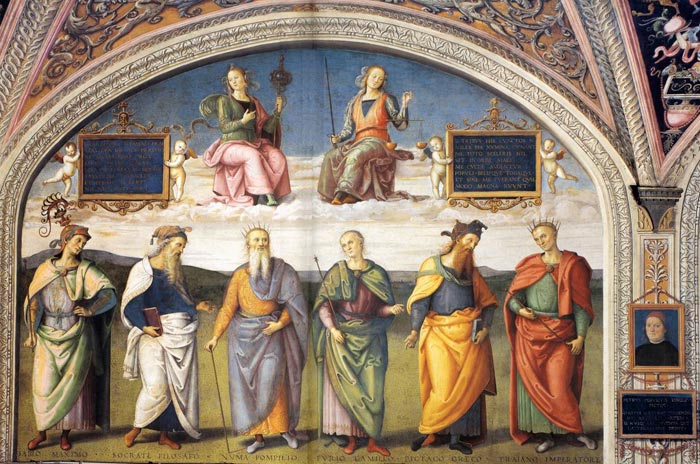 |
||
Pietro Perugino, Famous Men of Antiquity, Collegio del Cambio, Perugia
On the left Fabius Maximus, Socrates, and Numa Pompilius. The Cardinal Virtue Prudentia is above them. On the right Furius Camillus, Pittacus, and Trajan. The Cardinal Virtue Justitia is above them.
|
||
| The theme of the frescoes is a result of the influence of the humanist Francesco Maturanzio, a teacher at the Studium Perusinum university. The paintings represent the four Cardinal Virtues along with well known ancient figures. One of the dividing pillars features a self-portrait of Perugino. The passageway in the right hand corner leads to the chapel of St John the Baptist, which was restored in the 16th century and was decorated with frescoes by Giannicola di Paolo, an apprentice of Perugino (vault: 1511 and walls: 1528-29). On the back wall the scenes of the Transfiguration and the Adoration of the Shepherds can be seen, on the right wall the group of Prophets and Sibyls is depicted, and the statue of Justitia is placed between two carved griffins. Because of its vaulted ceiling decorated with grotesques, the Sala di Udienza (Council Room) seems taller than it actually is. Its decor appears so consistent that one would not suspect that it was actually executed in several stages. The Florentine woodcarver Domenico del Tasso (1440-1508) created the inlaid paneling and the richly carved "tribunal," or judges' bench in 1491-92. The walls were decorated with frescoes by Perugino in 1497-1500. The iconography on the walls are inspired by the triumph of the Virtues, following the model of Catone l’Uticense: the four Cardinal Virtues - Prudence, Justice, Strength and Temperance - embodied in exemplary figures taken from Greek and Roman history, and the three Theological Virtues - Faith, Hope and Charity - represented by the Transfiguration of Christ, the Nativity and the Prophets and the Sibyls. On the vault the triumph of the Planets is depicted, hinting at fortune. These frescoes are a masterpiece of Italian humanistic painting, surpassed only by the decoration of the Vatican Rooms by Raphael. Each of the two compartments (lunettes) on the left wall presents a row of six figures standing in front of a low landscape horizon. Above these, personifications of the four cardinal virtues sit enthroned on clouds, two in each lunette. Beside each of the Virtues is an ornamental inscription tablet flanked by putti and containing a Latin distich identifying her and celebrating the exemplars below. Each trio of figures is made up of two Romans and one Greek; their names appear on the ground beneath their feet. The represented famous men in the first compartment are Fabius Maximus, Socrates, Numa Pompilius, Furius Camillus, Pittacus, and Trajan. Above them the Cardinal Virtues Prudentia and Justitia are depicted. At the right we can see Perugino's self-portrait. For his arrangement of the heroes in the lunettes, Perugino borrowed from Ghirlandaio's paintings in the Sala dei Gigli in Florence's Palazzo Vecchio. More than likely he knew those works firsthand, for he had himself been commissioned to execute some of the paintings in that room in 1482. In the compartment of the right wall, on the left the prophets Isaiah, Moses, Daniel, David, Jeremiah, and Solomon are represented. On the right the Eritrean, Persian, Cumaean, Libyan, Tiburtine, and Delphian sibyls are depicted. Each figure is provided with a fragmentary prophecy on an inscription ribbon. Above, God the Father in a gloriole surrounded by angels can be seen. Art in Toscany | Il Perugino | Ornamentation of the Collegio del Cambio in Perugia Corso Vannucci |
||
| The best streets to wander around to get a feel of the old centre are the Corso Vannucci, Via dei Priori, Via A. Pascoli and Corso Cavour. Perugia's old centre hinges around Corso Vannucci, named after the local painter Pietro Vannucci (Perugino). The street, stately pedestrian thoroughfare constantly buzzing with action, runs from Piazza d'Italia to Piazza IV Novembre, the main town square. Corso Vannucci is lined with expensive shops selling the best known Italian designers, as well as good restaurants and cafes. |
||
San Pietro |
||
| The monastery was created around 996 over the former cathedral church, the early seat of Perugia's bishops, existing since the early seventh century, although the first document citing the abbot is from 1002. Its early patron was Pietro Vincioli, a Perugian noble, later canonized. In the following centuries the abbey increased greatly its power, until in 1398 it was burnt by the Perugini, as the abbot Francesco Guidalotti had taken part in the plot against Biordo Michelotti, chief of the popular party. The monastery reflourished with Pope Eugene IV, who united it to the Congregation of St. Justine of Padua, maintaining a position of prestige and power in the city. The abbey was temporarily suppressed by the French in 1799. The monks had aided the Perugine revolt of 1859 against the Papal government, and, after the Unification of Italy, the new government allowed them to remain in the Abbey. The monastery is preceded by a 15th century gate designed by Agostino di Duccio that leads to a monumental facade with three arcades, designed around 1614 by the Perugine architect Valentino Martelli: the first cloister is also by Martelli, with the second floor completed by Lorenzo Petrozzi. The entrance of the church is on the left side of the cloister. Remains of the facade of the ancient basilica can be seen on the left and the right of the fifteenth-century portal, with a portico including some frescoes from the fourteenth and fifteenth centuries. The polygonal belltower, on the right of the portal, was rebuilt in 1463-68 with Florentine-Gothic lines, based on a design by Bernardo Rossellino). The interior has a basilica plan, with a nave and two aisles. It has the most important collection of art in Perugia, after the Galleria Nazionale dell'Umbria. The nave is articulated by arcades on antique grey marble columns, probably coming from Roman constructions. The upper part is decorated with canvas depicting scenes from the Old and New Testaments, commissioned by Abbot Giacomo da San Felice da Salò and completed in 1591-1611. They were executed in Venice by Antonio Vassilacchi, a pupil of Paolo Veronese and Tintoretto. Also by Vassilacchi is the great canvas on the west wall, with the Triumph of the Benedictine orders. The central nave has a richly inlaid and colored coffered ceiling of wood by Benedetto di Giovanni da Montepulciano (1556) Other works of art include works by Ventura Salimbeni, Eusebio da San Giorgio, Orazio Alfani, copies after Perugino, Girolamo Danti (sacristy, 1574), Giovanni Lanfranco, Mino da Fiesole (a marble with Young Jesus, St. John the Baptist and St. Hyeronimus, in the Vibi Chapel), a Jesus in the Orchard attributed to Guido Reni,, two grand canvas by Giorgio Vasari, and a Pietà of Sebastiano dal Piombo's school. By Perugino himself is a series of Saints in the sacristy, once part of the Ascension altarpiece (1496), which once decorated the main altar of the church (now in the Museum at Lyon). The main feature of the presbytery (rebuilt by Martelli and decorated with works of art mainly of the late sixteenth century) is the intarsia of the wood-panelled choir, considered one of the most beautiful in Italy. It was begun by Bernardino di Luca Antonini in 1525-26, and completed by Stefano di Antoniolo Zambelli, from Bergamo, in 1535. Particularly noteworthy is the central door, with a relief portraying the Annunciation and Moses Saved from the Water by fra Damiano da Bergamo (1536). The Abbey has two more cloisters: one, called Chiostro Maggiore, is a Renaissance construction attributed to Guido da Settignano, another, also known as Chiostro delle Stelle, is from 1571. In front of the Abbey is the Giardino del Frontone, a former parade square of Braccio da Montone rebuilt into a garden with a tiny amphitheatre by the Alessi family in the eighteenth century. |
||
Basilica Di San Domenico |
||
| Piazza Giordano Bruno is dominated by the imposing structure of the Chiesa di San Domenico. San Domenico is a basilica church and the largest religious building in the whole Umbria. The church shows externally a late 16th century portal and a double Baroque staircase. The original building dates to 1304, and was constructed over a pre-existing one (known as San Domenico Vecchio), which had become inadequate after the growth of the Dominican Order. According to Giorgio Vasari, it was designed by Giovanni Pisano. During the early Middle Ages, this area was the site of the local horse market and fair. Tradition has it that the church was designed by Giovanni Pisano. In any case, its construction was completed in 1458, the year in which is was consecrated to St. Stephen by Pope Pius II. Before the 17th-century renovation of the interior, the building presented an enormous ‘hallenkirche’ plan with octagonal pilasters in laterite stone, pointed arches and large stained-glass windows. The bell-tower was once surmounted by a high steeple dating from the late 1400s and was the work of Gasperino di Antonio of Lombardy. It was shortened during the 15th century, probably for reasons of instability, although tradition identifies in this act the same motivations which prompted Pope Paul III to demolish the upper level of the church of San Ercolano. The front staircase was designed by Girolamo Ciofi of Cortona (1640). The doorway is dated 1596. Above its remain traces of a rose-window by Benedetto di Valdorcia of Siena (1415). Next to the church, walk along the narrow Via del Castellano for a terrific view of the south aisle chapel walls of the church. The rhythm of the red and white stone work is interrupted by a large gothic mullioned-window; the upper region bears a dentil shaped ornamentation also in red and white stone. Nearby, the house next to the Auditorium Marianum contains an early 14th-century painting of the Madonna and Child. |
||
In the interior of the church are a funerary monument to Pope Benedict XI, who died at Perugia in 1304 (perhaps executed by a pupil of Arnolfo di Cambio ), the Rosary Altar by Agostino di Duccio and the wood choir, dating to the late 14th century. The church once housed also the Perugia Altarpiece by Fra Angelico, now in the Galleria Nazionale dell'Umbria.
|
||
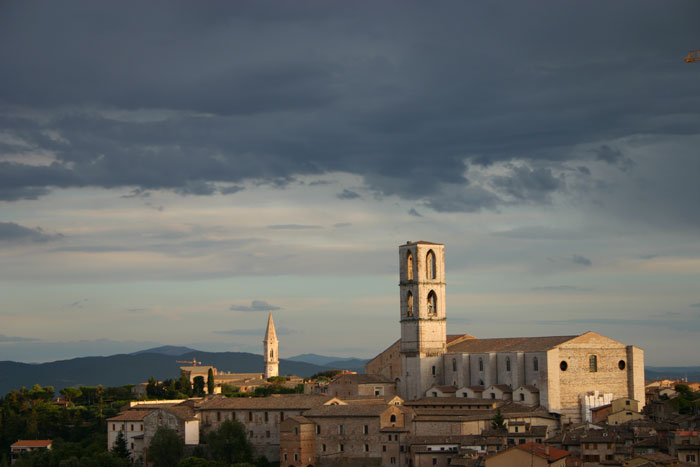 |
||
View with San Domenico church at sunset. Picture by Giovanni Dall'Orto, August 5, 2006 |
||
San Bevignate |
||
| The church of Saint Bevignate is a monument of extraordinary interest: it is the only church in Italy, and one of the few in Europe, that keeps an entire fresco cycle dedicated to the Templars, the famous monks-knights of the Crusades. The church was commissioned by the Templars in substitution of their former church of San Giustino d'Arna, from which they had been ousted in 1277. San Bevignate, to whom it is entitled, was a rather mysterious local hermit who had a notable following among Perugia's people but was in fact never officially canonized. The church was built c. 1250. In 1312, after the suppression of the Templar Order, it was acquired by the Hospitalliers. In 1324 Ricco di Corbolo, a rich Perugine merchant, acquired the whole complex and housed there a feminine monastic community. In 1517 the nuns left the convent, which returned to the Knights of Malta. In 1860 the church was secularized. The sober interior of the church has great similarities with the chapels built by the Templars in the Holy Land. It has a single nave with groin-vaulted ceiling. The square apse, containing typical Templar architectural motifs such as the cosmological cross and stars, is introduced by a large triumphal arch. Works of art include the Procession of Flagellants, a Battle Between Templars and Muslims, the Legend of San Bevignate and other 13th century frescoes.
|
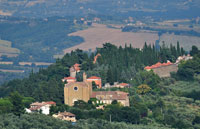 Chiesa di San Bevignate Chiesa di San Bevignate |
|
The church of S. Francesco al Prato (1253) |
||
| At the end of Via S. Francesco it is Piazza San Francesco, dominated by the church of St. Francis al Prato at the side of which, on the left, stands the Oratory of St. Bernardino. According to tradition, St Francis established the first Franciscan community of Perugia in 1212, on a site that later became the nunnery of San Francesco delle Donne. Whatever is the precise truth of this claim, it is certainly true that a Franciscan convent was established there early in the 13th century. In 1253, the Franciscans sold their land and buildings to a community of Benedictine nuns from Sant’ Angelo di Arenaria (or del Renaio), near Cenerente. Their nunnery became known as San Francesco delle Donne. Benedictine nuns of St. Angelo del Renaio bought this side together with the structures built on it, in 1253. When Franciscan Order was divided into Coventuals and Observants, St. Francis al Prato became the seat of the Conventuals. The nuns remained here until 1815, when the convent was suppressed. The Accademia delle Belle Arti 'P. Vannucci' was founded in 1573 by Orazio Alfani and Domenico Sozi. As from the beginning of the 20th century the academy has occupied the former convent of San Francesco al Prato. [1] The entrance is from the portico that joins the Oratorio di San Bernardino with San Francesco al Prato. The Museum includes an important gallery of plaster casts of 360 sculptures (including some by Canova), partly collected by the academy founders. |
||
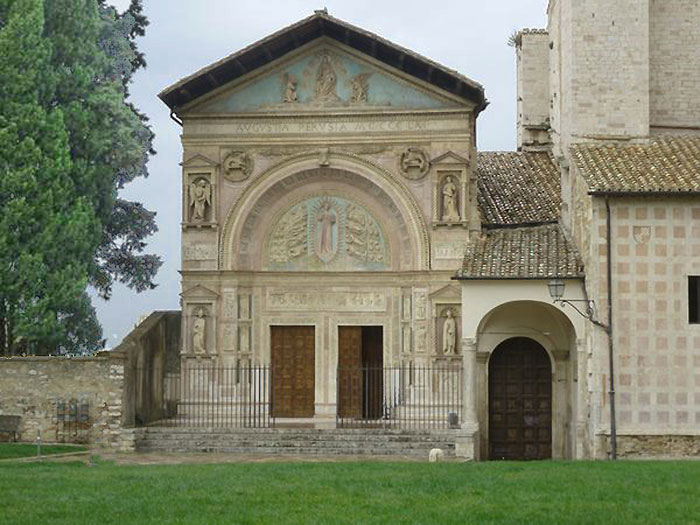 |
||
San Francesco al Prato, Oratorio di San Bernardino (1253)
|
||
References |
||||
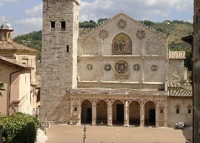 |
||||
The abbey of Sant'Antimo |
Cortona |
Spoleto, Duomo |
||
|
||||
|
This article incorporates material from the Wikipedia articles Perugia, Pietro Perugino, Galleria Nazionale dell'Umbria, Perugia Cathedral, San Pietro, Perugia and Sala delle Udienze del Collegio del Cambio, published under the GNU Free Documentation License, and from Ornamentation of the Collegio del Cambio in Perugia, at www.wga.hu. |
||||
|
||||
Podere Santa Pia |
Podere Santa Pia, garden view, April |
Crete Senesi, surroundings of Podere Santa Pia |
||
Montefalco |
Lago Trasimeno |
Florence, Duomo |
||
| History of Perugia |
||||
Perugia was an Umbrian settlement[5] but first appears in written history as Perusia, one of the 12 confederate cities of Etruria;[5] it was first mentioned in Q. Fabius Pictor's account, utilized by Livy, of the expedition carried out against the Etruscan league by Fabius Maximus Rullianus[6] in 310 or 309 BC. At that time a thirty-year indutiae (truce) was agreed upon;[7] however, in 295 Perusia took part in the Third Samnite War and was reduced, with Volsinii and Arretium (Arezzo), to seek for peace in the following year.[8]
|
||||
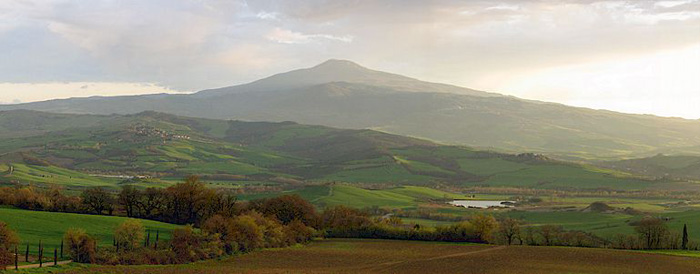 |
||||
Monte Amiata and the surroundings of Podere Santa Pia |
||||
Walking in Tuscany | Podere Santa Pia - Castiglioncello Bandini - Poggio all'Olmo - Monticello Amiata |
||||

